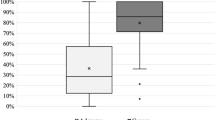Abstract
Having noted a discrepancy between endoscopic and histopathological diagnoses in cases of minute adenomas of the colon, a prospective study was designed to clarify which is appropriate, magnifying chromoendoscopy or histopathology of a specimen obtained by biopsy forceps. A total of 208 patients comprised the study population. The endoscopic diagnoses were performed with magnifying colonoscopies. We separated the detected lesions with type IIIL pit pattern following Kudo’s classification into two groups at random: in group A (n = 104) resected specimens were fixed with 20% buffered formalin without being flattened, whereas in group B (n = 104) the resected specimens were flattened using forceps before fixation and the specimens were cut under observation of their surface structure with stereomicroscopy. Comparison of the initial diagnoses between groups A and B showed that a total of 84.6% (88/104) of the lesions were diagnosed to be tubular adenomas histopathologically in group A, compared with 100% (104/104) in group B (P < 0.0001). Results for comparison of the secondary diagnoses between group A and group B showed that 14 of the 16 lesions were diagnosed as tubular adenomas histopathologically. Thereafter, 98.1% (102/104) of the lesions were diagnosed to be tubular adenomas histopathologically in group A (P = 0.4976). In conclusion, high-resolution magnifying chromoendoscopy is an appropriate procedure for the diagnosis of minute adenomas in comparison with histopathology of specimens obtained by biopsy forceps in this prospective study.





Similar content being viewed by others
References
Morson BC. Evolution of cancer of the colon and rectum. Cancer. 1974;34(Suppl.):845–849. doi:10.1002/1097-0142(197409)34:3+<845::AID-CNCR2820340710>3.0.CO;2-H.
Muto T, Kamiya J, Sawada T, et al. Small “flat adenoma” of the large bowel with special reference to its clinicopathologic features. Dis Colon Rectum. 1985;28:847–851. doi:10.1007/BF02555490.
Mitooka H, Fujimori T, Maeda S, et al. Minute flat depressed neoplastic lesions of the colon detected by contrast chromoscopy using an indigo carmine capsule. Gastrointest Endosc. 1995;41:453–459. doi:10.1016/S0016-5107(05)80003-3.
Fujii T, Rembacken BJ, Dixon MF, et al. Flat adenomas in the United Kingdom: are treatable cancers being missed? Endoscopy. 1998;30:437–443.
Hart AR, Kudo S, Mackay EH, et al. Flat adenomas exist in asymptomatic people: important implications for colorectal cancer screening programmes. Gut. 1998;43:229–231.
Kubota O, Kino I, Kimura T, et al. Nonpolypoid adenomas and adenocarcinomas found in background mucosa of surgically resected colons. Cancer. 1996;77:621–626. doi:10.1002/(SICI)1097-0142(19960215)77:4<621::AID-CNCR6>3.0.CO;2-J.
Kudo S, Tamura S, Nakajima T, et al. Diagnosis of colorectal tumorous lesions by magnifying endoscope. Gastrointest Endosc. 1996;44:8–14. doi:10.1016/S0016-5107(96)70222-5.
Axelrad AM, Fleischer DE, Geller AJ, et al. High-resolution chromoendoscopy for the diagnosis of diminutive colon polyps: implications for colon cancer screening. Gastroenterology. 1996;110:1253–1258. doi:10.1053/gast.1996.v110.pm8613016.
Konishi K, Kaneko K, Kurahashi T, et al. A comparison of magnifying and nonmagnifying colonoscopy for diagnosis of colorectal polyps: a prospective study. Gastrointest Endosc. 2003;57:48–53. doi:10.1067/mge.2003.31.
Hurlstone DP, Cross SS, Adam I, et al. Efficacy of high magnification chromoscopic colonoscopy for the diagnosis of neoplasia in flat and depressed lesions of the colorectum: a prospective analysis. Gut. 2004;53:284–290. doi:10.1136/gut.2003.027623.
Kiesslich R, Jung M, DiSario JA, et al. Perspectives of chromo and magnifying endoscopy. How, how much, when, and whom should we stain? J Clin Gastroenterol. 2004;38:7–13. doi:10.1097/00004836-200401000-00004.
Huang Q, Fukami N, Kashida H, et al. Interobserver and intra-observer consistency in the endoscopic assessment of colonic pit patterns. Gastrointest Endosc. 2004;60:520–526. doi:10.1016/S0016-5107(04)01880-2.
Tada S, Iida M, Yao T, et al. Stereomicroscopic examination of surface morphology in colorectal epithelial tumors. Hum Pathol. 1993;24:1243–1252. doi:10.1016/0046-8177(93)90222-3.
Kudo S, Hirota S, Nakajima T, et al. Colorectal tumours and pit pattern. J Clin Pathol. 1994;47:880–885. doi:10.1136/jcp.47.10.880.
Lambert R, Lightdale CJ (eds). The Paris endoscopic classification of superficial neoplastic lesions: esophagus, stomach, and colon. Gastrointest Endosc. 2003;58(6 suppl.):S1–S27.
Matek W, Lux G, Riemann JF, et al. Initial experience with the new electronic endoscope. Endoscopy. 1984;16:20–21.
Sivak MichaelV Jr, Fleischer DE. Colonoscopy with a videoendoscope: preliminary experience. Gastrointest Endosc. 1984;30:1–5.
Bank Simmy, Cobb JS, Burns DG, et al. Dissecting microscopy of rectal mucosa. Lancet. 1970;295:64–65. doi:10.1016/S0140-6736(70)91847-7.
Morita T, Tamura S, Miyazaki J, et al. Evaluation of endoscopic and histopathological features of serrated adenoma of the colon. Endoscopy. 2001;33:761–765. doi:10.1055/s-2001-16525.
Jaramillo E, Tamura S, Mitomi H. Endoscopic appearance of serrated adenoma in the colon. Endoscopy. 2005;37:254–260. doi:10.1055/s-2005-861007.
Tamura S, Furuya Y, Tadokoro T, et al. Pit pattern and three-dimensional configuration of isolated crypts from the patients with colorectal neoplasm. J Gastroenterol. 2002;37:798–806. doi:10.1007/s005350200133.
Tamura S, Yokoyama Y, Tadakoro T, et al. Pit pattern and pathological diagnosis in the patients with colorectal tumors. Dig Endosc. 2001;13(Suppl.):S6–S7. doi:10.1046/j.1443-1661.2001.0130s10S6.x.
Author information
Authors and Affiliations
Corresponding author
Rights and permissions
About this article
Cite this article
Yamada, T., Tamura, S., Onishi, S. et al. A Comparison of Magnifying Chromoendoscopy Versus Histopathology of Forceps Biopsy Specimen in the Diagnosis of Minute Flat Adenoma of the Colon. Dig Dis Sci 54, 2002–2008 (2009). https://doi.org/10.1007/s10620-008-0573-7
Received:
Accepted:
Published:
Issue Date:
DOI: https://doi.org/10.1007/s10620-008-0573-7




